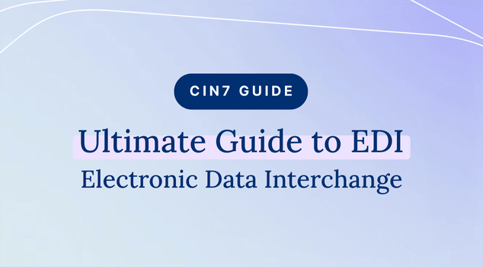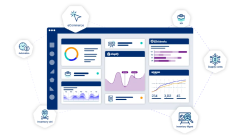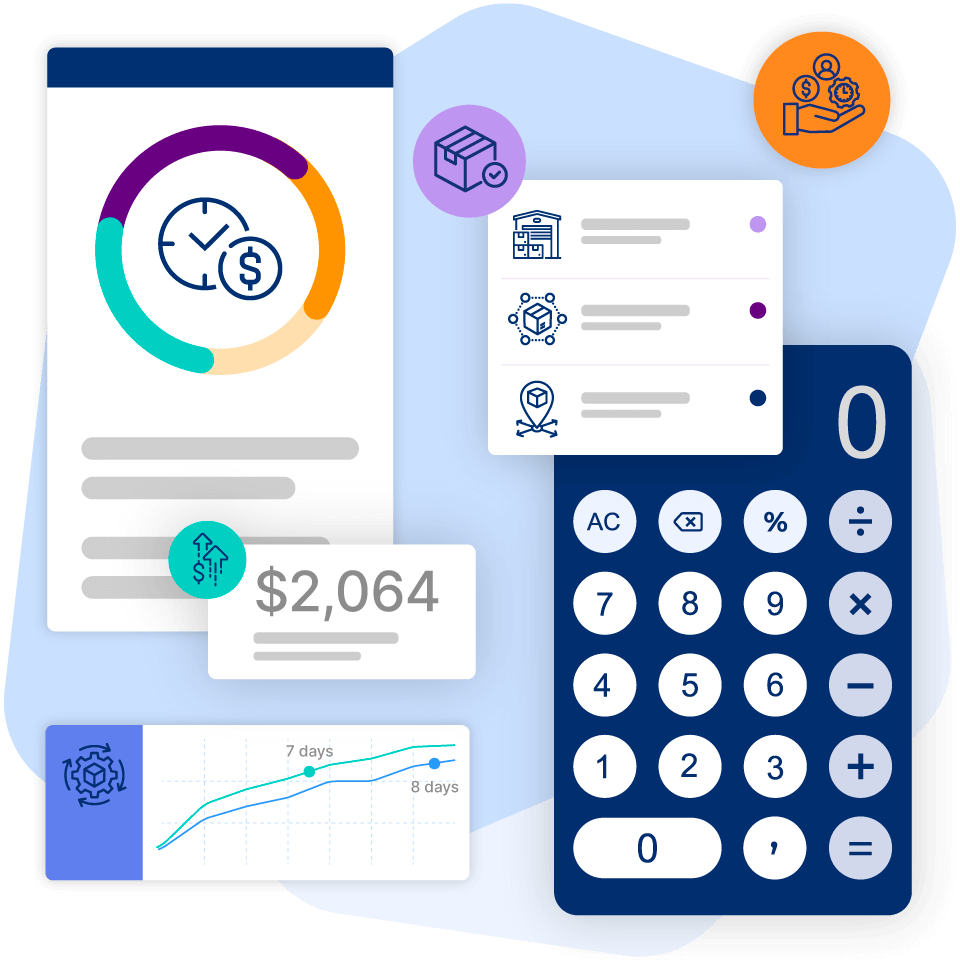Ultimate Guide to EDI: How Built-in EDI Simplifies Supply Chain Integration

Introduction to EDI
Electronic data interchange (EDI) is a system that enables the electronic exchange of business documents between different computer systems, either company to company or company to client. It’s a quick and efficient method that reduces manual effort and human error commonly associated with paper-based methods.
What is EDI?
Electronic data interchange, or EDI, is the standardized computer-to-computer exchange of information between two or more partner entities. It digitally transfers data between companies, customers, partners, and internal systems.
How it works:
- EDI software translates data into a standardized format.
- The formatted data is transmitted electronically between trading partners.
- The receiving system decodes the data and integrates it into its own operations.
Why businesses use EDI
Operational efficiency is a priority for businesses of all sizes. EDI helps businesses automate communication, improve operations, and streamline transactions. Industries such as manufacturing, retail, healthcare, finance, and logistics rely on EDI to exchange critical documents like:
- Invoices
- Purchase orders
- Shipping notices
- HR and finance documents
For example, large retailers that source from multiple manufacturers and suppliers depend on EDI automation to ensure accurate, recurring product shipments. Without a seamless data exchange, supply chain disruptions can lead to inventory shortages, affecting profitability.
How EDI improves efficiency, accuracy, and compliance
EDI is faster, more secure, and more accurate than traditional communication methods like fax, email, or mail.
1. Efficiency
- Automates data exchange, reducing processing time for orders and invoices.
- Eliminates paper-based processes, reducing administrative workload.
2. Accuracy
- Reduces human errors caused by manual data entry.
- Ensures consistent data formatting across all transactions.
3. Compliance
- Helps businesses meet industry standards for digital transactions.
- Provides secure data exchange with encryption and authentication protocols.
Without EDI, the average U.S. small retailer has only 63% inventory accuracy—highlighting the importance of automation in modern business operations.
Types of EDI and Communication Methods
EDI solutions vary based on communication methods, message formats, and implementation models. The right choice depends on a company’s size, industry, and operational needs.
Some businesses prioritize direct EDI for greater control over their transactions, while others opt for third-party services like VANs for additional security, translation services, and technical support—especially companies with multi-channel inventory management needs.
Below are the seven main types of EDI solutions, along with how they work:
1. Direct EDI (Point-to-Point) – One-to-One Connection Between Trading Partners
Direct EDI involves building direct connectors between two businesses for a one-to-one data exchange. This model requires both parties to use the same communication protocols, ensuring seamless data sharing.
- Use Case: Ideal for businesses that frequently exchange high volumes of documents with the same partners.
- Pros: Full control over EDI transactions, lower long-term costs.
- Cons: Requires custom infrastructure and ongoing maintenance, which can be complex to scale.
2. EDI Network Provider (VAN) – Third-Party Service for Managing Transactions, Translations, and Security
A Value-Added Network (VAN) acts as an intermediary between trading partners, managing document mapping, security, reporting, and technical support. Businesses use VANs to streamline EDI workflows while maintaining compliance and security.
- Use Case: Best for companies handling transactions across multiple partners.
- Pros: Secure data transmission, format translations, centralized document mailbox.
- Cons: Monthly subscription and usage fees can increase costs over time.
3. Hybrid EDI – Combination of Direct EDI and VAN for Flexibility and Cost Optimization
Hybrid EDI solutions combine direct EDI connectors for high-frequency transactions with VAN services for less frequent transactions. This model is cost-efficient while maintaining operational flexibility.
- Use Case: Large enterprises needing scalable, high-volume EDI processing.
- Pros: Balances cost savings and efficiency, ensuring agility.
- Cons: Requires system management to coordinate multiple integration points.
4. Fully Managed EDI Services – End-to-End Outsourcing for Businesses That Don’t Want to Manage Infrastructure
Fully managed EDI services outsource the entire document interchange process to a third-party provider. These services connect directly to a company’s ERP system, handling mapping, processing, reporting, and compliance on their behalf.
- Use Case: Large businesses in eCommerce, manufacturing, and retail that don’t want to manage EDI operations.
- Pros: Minimal technical involvement, 24/7 support, and compliance management.
- Cons: Higher outsourcing costs and less direct control over EDI processes.
5. Indirect EDI – Using Intermediaries to Simplify Transactions Across Multiple Partners
Indirect EDI relies on third-party intermediaries (such as VANs) to manage, transmit, and translate EDI documents across multiple business partners.
- Use Case: Businesses handling large-scale supplier networks that require multi-party compatibility.
- Pros: Reduced complexity—no need for businesses to manage integrations directly.
- Cons: Subscription fees and outsourcing reliance may reduce long-term flexibility.
6. Web EDI – Cloud-Based, Browser-Accessible EDI for SMBs Needing Easy Adoption
Web EDI allows businesses to access EDI transactions through a browser without complex software installations. This cloud-based approach provides accessibility and ease of use, making it a popular choice for small and medium-sized businesses (SMBs).
- Use Case: Ideal for SMBs working with larger EDI-enabled partners.
- Pros: Cost-effective, easy to implement, doesn’t require extensive IT resources.
- Cons: Limited functionality compared to fully integrated EDI solutions.
7. Mobile EDI – EDI Transactions via Mobile Apps for Greater Accessibility
Mobile EDI enables businesses to send and receive EDI transactions via mobile devices, offering greater flexibility and real-time updates. It is particularly useful for on-the-go business operations such as logistics and supply chain tracking.
- Use Case: Businesses that require real-time updates on EDI transactions from anywhere.
- Pros: User-friendly, real-time data access, increased mobility.
- Cons: May have limited integration with full-scale EDI systems.
EDI Standards and Interoperability
EDI operates on standardized formats that ensure data consistency, accuracy, and compatibility across businesses, industries, and international markets. These standards define structure, syntax, and semantics, allowing different systems to communicate seamlessly.
Common EDI Standards
ANSI ASC X12 (North America)
The ANSI ASC X12 standard is widely used in North America and governs the electronic exchange of business documents such as purchase orders (EDI 850), invoices (EDI 810), and advance ship notices (EDI 856). It is commonly used in retail, healthcare, logistics, and finance to ensure efficient, standardized transactions.
EDIFACT (Global Standard for Commerce and Transport)
EDIFACT (Electronic Data Interchange for Administration, Commerce, and Transport) is an international standard managed by the United Nations (UN/CEFACT). It is widely adopted in Europe, Asia, and global trade networks, offering a unified approach to document exchange across borders.
Ensuring Compatibility Across Partners and Industries
EDI standards bridge communication gaps between different business systems, ensuring that:
- Trading partners use a common language for data exchange.
- Different industries follow regulatory compliance for secure transactions.
- International businesses can integrate seamlessly with global supply chains.
Using recognized EDI standards eliminates formatting inconsistencies, reformatting errors, and misinterpretations, ensuring that transactions flow accurately and efficiently.
How Standardized Formats Improve Accuracy and Reduce Manual Errors
Standardized EDI formats automate document translation into a universal format, eliminating manual reformatting between systems. This improves:
- Data Accuracy: Prevents human errors in purchase orders, invoices, and shipment tracking.
- Processing Speed: Reduces transaction delays by automating approvals and document routing.
- Operational Efficiency: Streamlines communication between vendors, suppliers, and retailers.
By adopting ANSI ASC X12, EDIFACT, and other global EDI formats, companies minimize miscommunication, enhance transaction accuracy, and accelerate business processes.
EDI Integration with Business Systems
For EDI to maximize efficiency, it must integrate with existing business systems, ensuring that electronic transactions are seamlessly processed, recorded, and managed.
Importance of Seamless Integration with:
1. ERP Systems (Cin7 Omni, NetSuite, SAP)
Integrating EDI with Enterprise Resource Planning (ERP) software enables businesses to:
- Automate order-to-cash and procure-to-pay workflows.
- Improve inventory tracking and supply chain coordination.
- Reduce manual intervention in financial and operational processes.
2. Inventory Management Software
EDI integration with inventory management systems ensures:
- Real-time stock updates, preventing overselling and stockouts.
- Automated order fulfillment, reducing processing delays.
- Better demand forecasting by analyzing historical sales and supplier data.
3. Finance & Accounting Tools (QBO, Xero)
EDI integration with finance software streamlines invoice processing, payments, and reconciliation by:
- Automating invoice validation and approval workflows.
- Reducing financial reporting errors with consistent transaction data.
- Ensuring compliance with tax and regulatory requirements.
4. HR and CRM Systems
For HR and payroll, EDI ensures that:
- Employee records, payroll, and benefits administration sync across systems.
- Hiring, termination, and salary changes are reflected in compliance documents.
For CRM (Customer Relationship Management), EDI enables:
- Automated order tracking and status updates for customers.
- Better coordination between sales, logistics, and customer service.
Benefits of EDI Integration:
Eliminates Manual Data Entry – Reduces human errors and processing time.
Reduces Errors and Delays – Ensures accurate, timely data transfers.
Automates Workflows for Improved Efficiency – Enhances supply chain visibility, transaction processing, and business intelligence.
By integrating EDI with key business systems, companies gain real-time insights, optimize supply chain operations, and improve overall business performance.
Choosing the Right EDI Solution
Implementing an EDI solution is a critical step toward digital transformation, enabling seamless communication, data automation, and system integration. However, selecting the right EDI solution depends on key factors such as cost, scalability, ease of use, and provider capabilities.
Key Factors to Consider
Before choosing an EDI provider, businesses should evaluate the following:
1. Cost-Effectiveness
EDI implementation involves various costs, including the cost of goods and ownership. Businesses should assess:
- Software & Hardware – Licensing fees, cloud subscriptions, or on-premise setups.
- Implementation & Training – Initial setup, customization, and staff training.
- Maintenance & Support – Ongoing costs for upgrades, troubleshooting, and compliance updates.
Assessing these factors ensures that your EDI solution delivers value without excessive overhead costs.
2. Scalability
A good EDI solution must support business growth by handling increased transaction volumes and expanding supply chains. Consider whether the EDI system can:
- Scale alongside rising order volumes and multiple trading partners.
- Handle multi-channel integration (eCommerce, warehouses, suppliers).
- Offer hybrid models for optimized cost and efficiency.
3. Ease of Use
Opting for an intuitive EDI platform minimizes technical complexity and ensures smooth adoption across departments. Businesses should look for:
- User-friendly dashboards for easy monitoring and reporting.
- Automation features to reduce manual intervention.
- Low-code or no-code solutions for faster deployment.
How to Evaluate EDI Providers
Selecting an EDI vendor requires careful assessment of their industry experience, integration capabilities, and support services.
1. Experience in Your Industry
Different industries have specific EDI standards and compliance requirements. Choose a provider with:
- Proven expertise in your sector (retail, healthcare, manufacturing, etc.).
- Support for industry-specific document types and workflows.
- A track record of successful EDI implementations.
2. Integration Capabilities with Existing Systems
Seamless EDI integration with existing business systems ensures smooth data flow across:
- ERP platforms (Cin7 Omni, NetSuite, SAP).
- Inventory management systems for real-time stock tracking.
- Finance tools (QBO, Xero) for automated invoice processing.
- HR & CRM systems for synchronized workforce and customer management.
3. Support Services and Security Compliance
Reliable customer support and security compliance are crucial in EDI adoption. Businesses should ensure that their provider offers:
- 24/7 support and troubleshooting.
- Data encryption and cybersecurity measures.
- Regulatory compliance with industry-specific standards like ANSI ASC X12 and EDIFACT.
Types of EDI Solutions
EDI solutions vary based on deployment models, communication methods, and operational needs. Below are the main types:
1. Cloud-Based EDI vs. On-Premise EDI
- Cloud-Based EDI – Hosted on external servers, offering scalability, lower costs, and automatic updates.
- On-Premise EDI – Locally-installed software that provides full control but requires high maintenance costs.
2. VAN vs. Direct EDI vs. Hybrid Models
- VAN (Value-Added Network) – Third-party intermediary handling security, document mapping, and compliance.
- Direct EDI (Point-to-Point) – One-to-one connection without intermediaries, ideal for high-volume trading partners.
- Hybrid EDI – A mix of direct EDI and VAN, allowing businesses to balance cost and efficiency.
Cin7’s Built-in EDI: A Smarter Alternative
Choosing the right EDI solution depends on finding a system that works seamlessly with your business and trading partners. That’s why Cin7 Omni inventory management software includes built-in EDI functionality, eliminating the need for third-party providers and internal IT resources.
By integrating EDI directly into its inventory management system, Cin7 simplifies the entire EDI process, reducing complexities and enhancing efficiency.
How Cin7 Eliminates the Need for Third-Party EDI Providers
Unlike standalone EDI platforms that require separate software, integrations, and maintenance, Cin7’s all-in-one solution offers:
- Pre-configured EDI connections with major retailers and suppliers.
- Automated order processing and inventory updates.
- Seamless data exchange without manual intervention.
With Cin7’s built-in EDI, businesses can streamline operations, reduce errors, and accelerate order fulfillment, all from a single platform.
Benefits of Built-in EDI
Seamless Workflow Automation
- Orders, invoices, and shipments are automatically processed, reducing manual work.
- EDI transactions sync in real-time with inventory, finance, and supply chain data.
Faster Implementation & Reduced IT Burden
- Pre-integrated EDI features eliminate complex software installations.
- No need for an in-house IT team to manage EDI transactions.
Cost Savings & Increased Efficiency
- Removes the cost of third-party EDI providers.
- Reduces administrative overhead with automated document processing.
- Speeds up transaction times, minimizing order-to-cash cycles.
By leveraging Cin7’s EDI capabilities, businesses experience faster time-to-value, benefiting from efficient data exchange, standardized processes, and improved partner collaboration.
Conclusion: Streamlining Operations with EDI
EDI has become an essential tool for modern businesses, enabling them to improve efficiency, reduce costs, and enhance supply chain accuracy.
By implementing the right EDI solution, businesses can:
- Eliminate manual data entry errors.
- Optimize workflows and reduce transaction delays.
- Scale operations seamlessly as they grow.
For companies looking to simplify EDI management, Cin7’s built-in EDI provides an all-in-one solution that integrates seamlessly with inventory, finance, and order management systems—eliminating the need for third-party providers.
Ready to streamline operations? Explore Cin7’s built-in EDI software today and take your business to the next level!
Frequently Asked Questions
The success of modern-day supply chain management is largely dependent on how efficiently businesses exchange information and insights. This covers all aspects of the supply chain between demand and fulfillment but sharing business data outside your organization requires you to be in complete control as well as safeguard your interests. The basic step in this direction is sharing order process details, inventory management reports, warehousing inputs, pipeline inventory, and shipping.
Generally, two types of solutions facilitate data sharing and pooling across organizations: EDI and API. Let us understand the difference between the two and which one is the ideal choice for supply chain management:
What are examples of EDI?
Purchase orders, invoices, shipping notices, and inventory documents are all examples of the electronic data transmitted and received through EDI systems. They are standardized business documents that are automatically transmitted and translated between a business and its partners.
What’s the difference between API and EDI?
API (application programming interface) and EDI are both technologies used to exchange data between different systems, but they have different purposes. API facilitates real-time interaction and data exchange between applications and services, while EDI focuses on the standardized exchange of business documents between partners.
What are EDI tools?
EDI tools are software solutions with dedicated EDI functionalities like ERP systems, cloud-based EDI platforms, and specialized applications for specific industries and document types. These tools enable businesses to efficiently conduct electronic transactions and automate document exchange processes.
More from the blog
View All Posts
An in-depth look at setting up EDI for e-commerce brands
Read More
Mastering your year-end stocktake: Tips for product businesses
Read More




